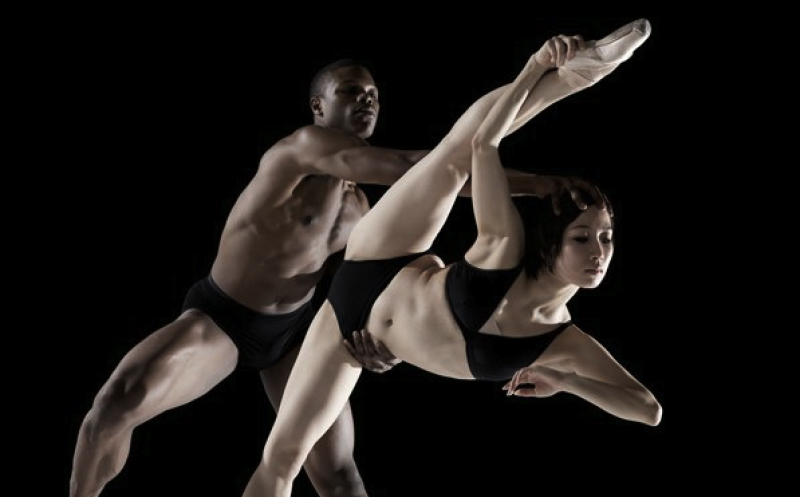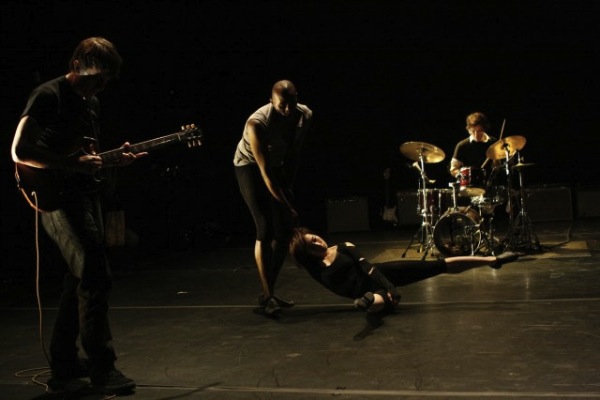Armitage Gone! Dance, Queen Elizabeth Hall | reviews, news & interviews
Armitage Gone! Dance, Queen Elizabeth Hall
Armitage Gone! Dance, Queen Elizabeth Hall
A youthful reputation as a punk ballet-maker is hard to match up to 30 years on

I wasn’t around to see when Karole Armitage won her spurs in her twenties as a punk ballet choreographer in America in the 1970s and early Eighties, so we must rely on her programme-sheet biography to explain to us that she is “seen by some critics as the true choreographic heir" to George Balanchine and Merce Cunningham. After last night’s dismal showing by her group, Armitage Gone!
It had started badly with Armitage stepping up in a sparse Queen Elizabeth Hall to lecture us on quantum mechanics, Einstein’s relativity theory and string theory, in a garrulous, blurry way that ended with her saying kindly, “This is all a way to, you know, think about reality.” She added that there would be a Q&A at the end “when you’ll be able to talk to me”. For a nano-second you could hear the audience's breath being held and released, as eyes rolled in polite British disbelief.
To business, then, with the two offerings: a new creation called Two Theories, allegedly illustrating the bittiness of quantum mechanics followed by the glueyness of string theory, and Drastic-Classicism, the 1981 work that made Armitage's reputation, which with its Goth ripped clothing and aggressive attitude is at least a vital souvenir of its time.
These are leftovers of Eighties William Forsythe and Michael Clark reheated in the intellectual microwave of today’s science buzzwords
Both have crashing, slashing scores by the renowned punk guitarist of the Seventies, Rhys Chatham; both turned to ear-splitting decibels. But even aural disorientation could not fully muddle me into thinking Two Theories was anything other than a job lot of six-packed gym bunnies trained to do little more than smack their legs into spatchcock splits and flare their hands, leftover mannerisms of Eighties William Forsythe and Michael Clark reheated in the intellectual microwave of today’s science buzzwords.
Frankly it was a waste of time watching such inexpert dancers in work that seems to want to continue to make some sort of social stand about ballet tradition. Would it not be more subversive if they had stretched feet, controlled legs, alert torsos, poised backs, receptive shoulders, quick eyes, refined lines, all the weaponry of ballet that they could then switch, with more devastating effect, to protest mode?
But the women’s feet wore pointe shoes with as little interest as if they were stilts, the men were a flabby set of movers, and I have a prejudice against choreographers who give dancers a lot of balancing on one leg to do and then don’t train the dancers not to wobble about like ropes in a typhoon. Edouard Lock’s La La La Human Steps were miracles of articulation and bravura next to this lot.
 Drastic-Classicism saw the thin audience dwindle further, possibly causing a late-night rush to neuro-otology departments because four guitarists and a drum kit made an even more torturously loud din than you imagined possible from the previous piece. Extraordinary how orchestras are banned from playing Tchaikovsky’s Sleeping Beauty without sound protection when dance theatres from Rosebery Avenue to Belvedere Road are busy dismantling the audience’s hearing with their wicked boy's-own sound systems and crepuscular lighting, as if all a dance fan needed was big eyes and no eardrums.
Drastic-Classicism saw the thin audience dwindle further, possibly causing a late-night rush to neuro-otology departments because four guitarists and a drum kit made an even more torturously loud din than you imagined possible from the previous piece. Extraordinary how orchestras are banned from playing Tchaikovsky’s Sleeping Beauty without sound protection when dance theatres from Rosebery Avenue to Belvedere Road are busy dismantling the audience’s hearing with their wicked boy's-own sound systems and crepuscular lighting, as if all a dance fan needed was big eyes and no eardrums.
The piece has Eighties smarts - it slams violent punky females in pointe shoes into a slamdunk jam session with hard rock’s sullen male guitarists and drummers. The girls interfere persistently with the boys’ instruments, like groupies demanding a fix, refusing to behave and mockingly spreading their legs. They form secret phalanxes at the back in the dark and charge on the audience. Barriers are toppled between dancers and musicians, between performers and audience. The fact that the work used balletic tropes this way, in an age of old men’s ballet (Balanchine, Cunningham and Ashton were all venerable by then), seems a good, brutal ladette joke, and Armitage's hard-nosed reputation got her commissions for pop video choreography from Madonna and Michael Jackson.
Time marches on, disapprovingly. A quarter-century later, X Factor routines and Beyoncé videos look much like Armitage's signature piece, and today's ladettes make her stroppy gals look like attention-deficient Brownies. All in all, a drastically uninspiring evening.
- Armitage Gone! Dance performs again tonight at the Queen Elizabeth Hall, London, as part of Dance Umbrella 2011
Share this article
Add comment
more Dance
 All You Need Is Death review - a future folk horror classic
Irish folkies seek a cursed ancient song in Paul Duane's impressive fiction debut
All You Need Is Death review - a future folk horror classic
Irish folkies seek a cursed ancient song in Paul Duane's impressive fiction debut
 MacMillan Celebrated, Royal Ballet review - out of mothballs, three vintage works to marvel at
Less-known pieces spanning the career of a great choreographer underline his greatness
MacMillan Celebrated, Royal Ballet review - out of mothballs, three vintage works to marvel at
Less-known pieces spanning the career of a great choreographer underline his greatness
 Carmen, English National Ballet review - lots of energy, even violence, but nothing new to say
Johan Inger's take on Carmen tries but fails to make a point about male violence
Carmen, English National Ballet review - lots of energy, even violence, but nothing new to say
Johan Inger's take on Carmen tries but fails to make a point about male violence
 WAKE, National Stadium, Dublin review - a rainbow river of dance, song, and so much else
THISISPOPBABY serves up a joyous tapestry of Ireland contemporary and traditional
WAKE, National Stadium, Dublin review - a rainbow river of dance, song, and so much else
THISISPOPBABY serves up a joyous tapestry of Ireland contemporary and traditional
 Swan Lake, Royal Ballet review - grand, eloquent, superb
Liam Scarlett's fine refashioning returns for a third season, and looks better than ever
Swan Lake, Royal Ballet review - grand, eloquent, superb
Liam Scarlett's fine refashioning returns for a third season, and looks better than ever
 First Person: Ten Years On - Flamenco guitarist Paco Peña pays tribute to his friend, the late, great Paco de Lucía
On the 10th anniversary of his death, memories of the prodigious musician who broadened the reach of flamenco into jazz and beyond
First Person: Ten Years On - Flamenco guitarist Paco Peña pays tribute to his friend, the late, great Paco de Lucía
On the 10th anniversary of his death, memories of the prodigious musician who broadened the reach of flamenco into jazz and beyond
 Dance for Ukraine Gala, London Palladium review - a second rich helping of international dancers
Ivan Putrov's latest gala was a satisfying mix of stars and young hopefuls
Dance for Ukraine Gala, London Palladium review - a second rich helping of international dancers
Ivan Putrov's latest gala was a satisfying mix of stars and young hopefuls
 Nelken: A Piece by Pina Bausch, Sadler's Wells review - welcome return for an indelible classic
A new generation of gifted performers for us to get to know
Nelken: A Piece by Pina Bausch, Sadler's Wells review - welcome return for an indelible classic
A new generation of gifted performers for us to get to know
 Dark With Excessive Bright, Royal Ballet review - a close encounter with dancers stripped bare
The Royal's Festival of New Choreography launches with an unforgettable walk in the dark
Dark With Excessive Bright, Royal Ballet review - a close encounter with dancers stripped bare
The Royal's Festival of New Choreography launches with an unforgettable walk in the dark
 La Strada, Sadler's Wells review - a long and bumpy road
Even the exceptional talents of Alina Cojocaru can't save dance adaptation of Fellini film
La Strada, Sadler's Wells review - a long and bumpy road
Even the exceptional talents of Alina Cojocaru can't save dance adaptation of Fellini film
 First Person: pioneering juggler Sean Gandini reflects on how the spirit of Pina Bausch has infiltrated his work
As Tanztheater Wuppertal Pina Bausch's 'Nelken' comes to Sadler’s Wells, a tribute from across the art forms
First Person: pioneering juggler Sean Gandini reflects on how the spirit of Pina Bausch has infiltrated his work
As Tanztheater Wuppertal Pina Bausch's 'Nelken' comes to Sadler’s Wells, a tribute from across the art forms
 Manon, Royal Ballet review - a glorious half-century revival of a modern classic
Fifty years on, Kenneth MacMillan's crash-and-burn anti-heroine is riding high
Manon, Royal Ballet review - a glorious half-century revival of a modern classic
Fifty years on, Kenneth MacMillan's crash-and-burn anti-heroine is riding high

Comments
Super harsh "review"... more